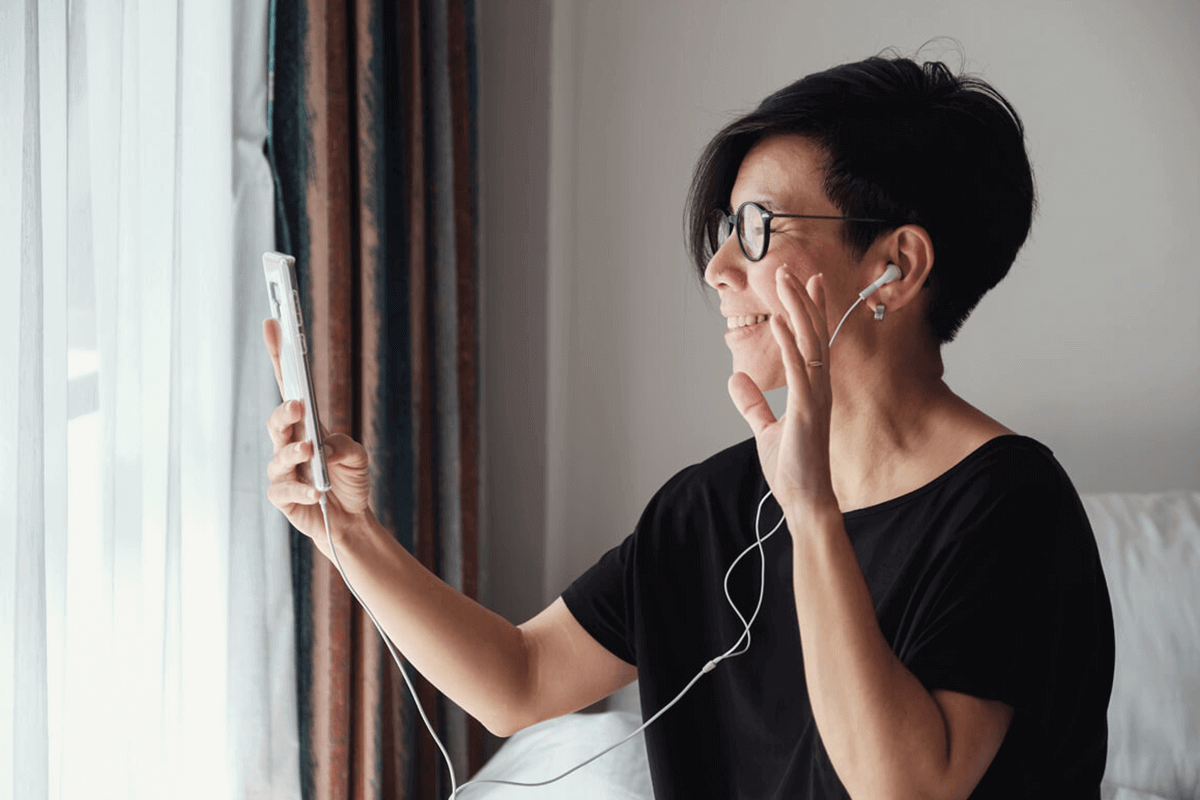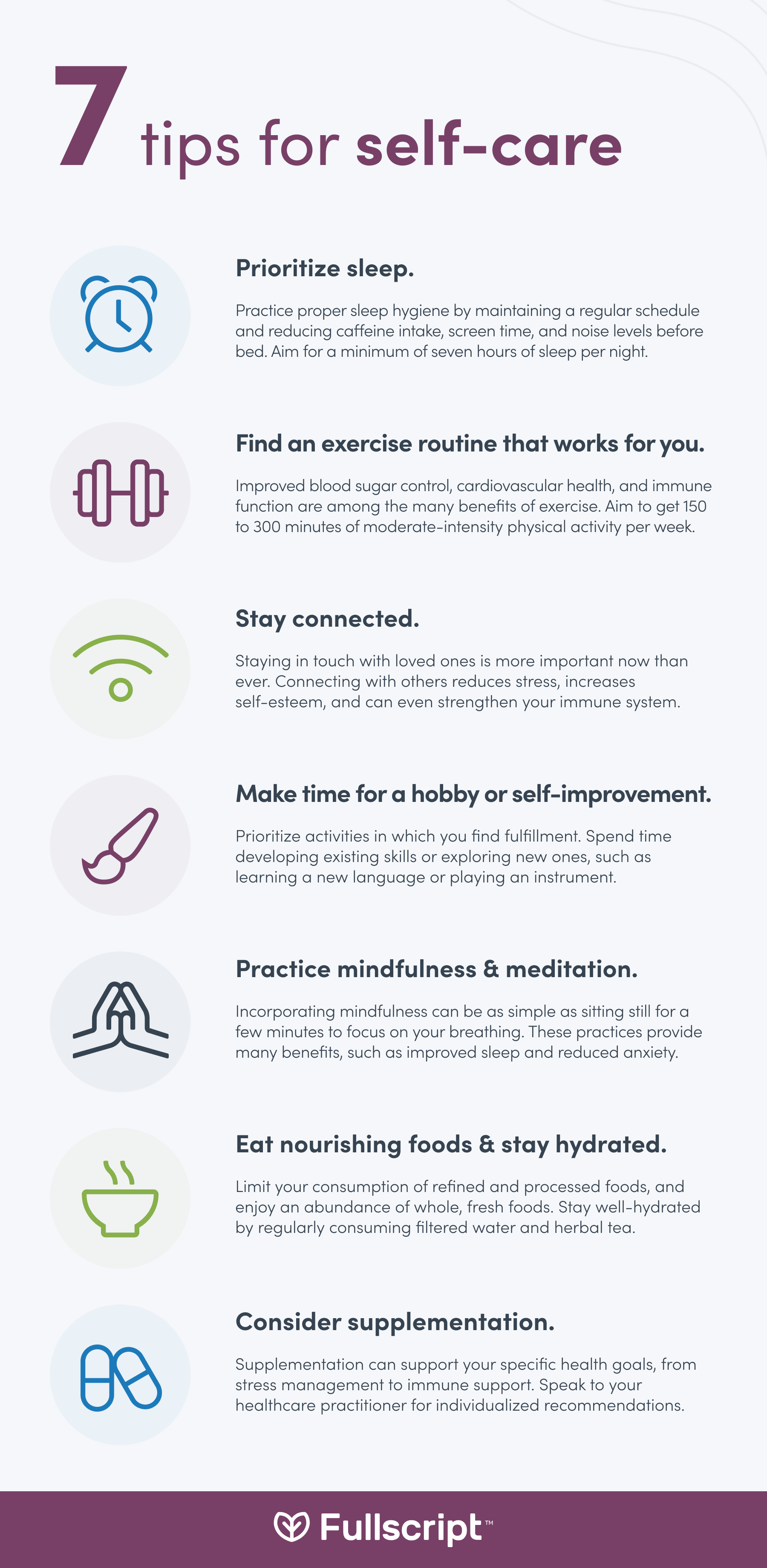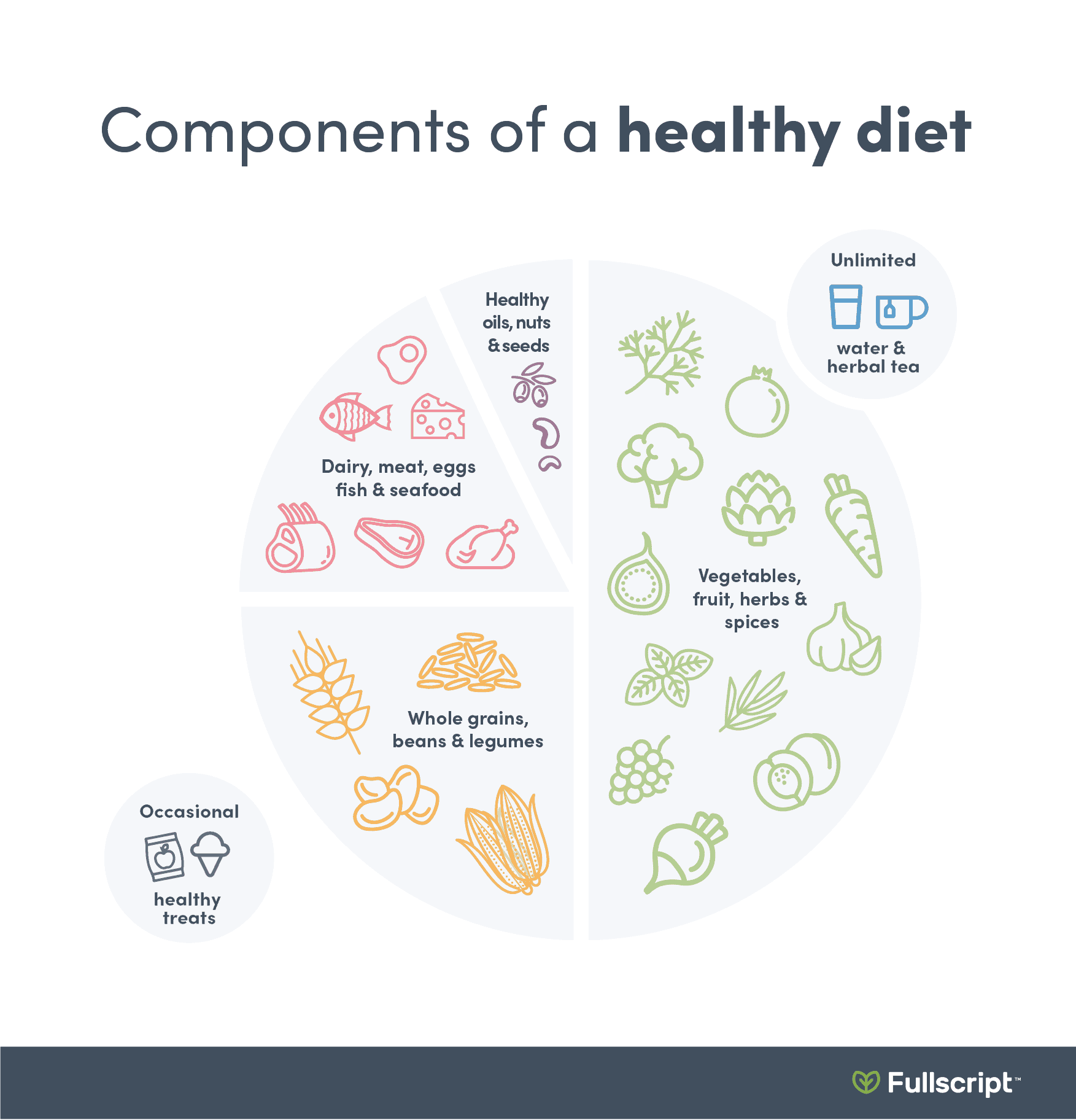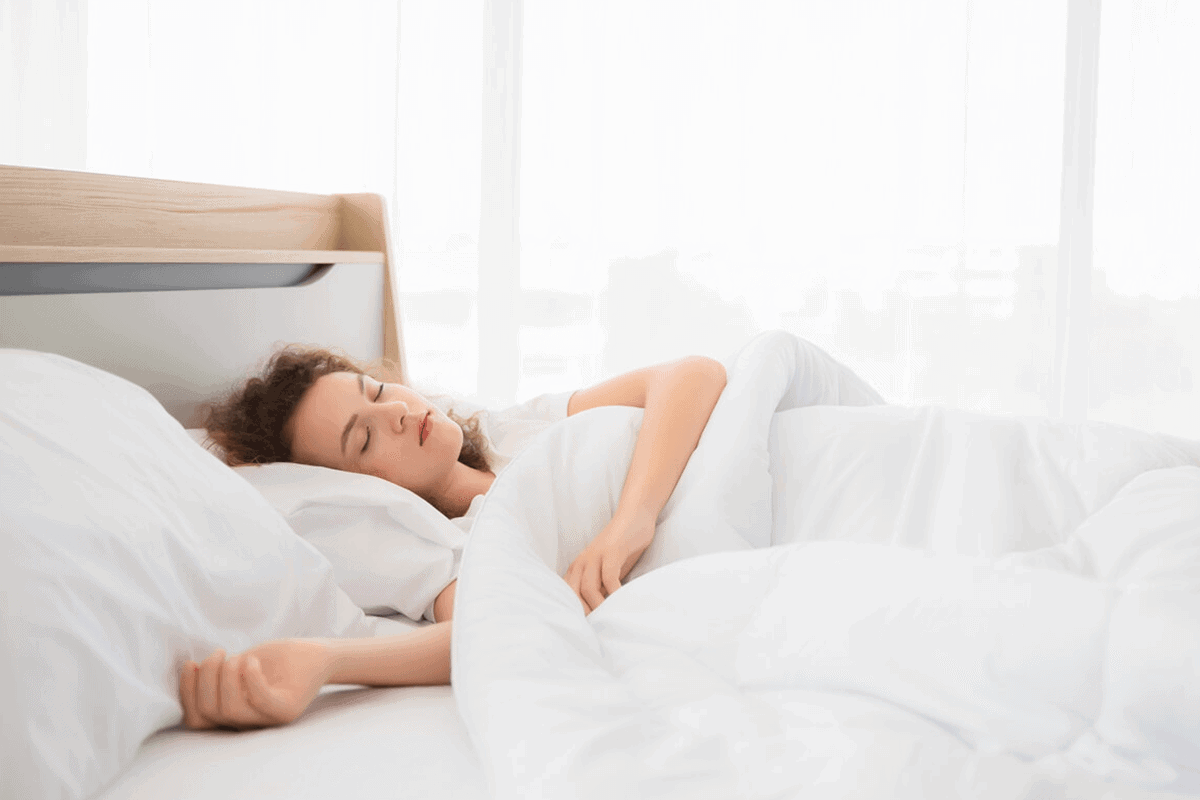Tips to Stay Healthy During Self-isolation
Source:
Web: https://fullscript.com/blog/health-tips-for-self-isolation?utm_source=email&utm_medium=patientcomms&utm_campaign=all-apr-2-2020&mkt_tok=eyJpIjoiTkRjME16SXdZemt4WW1FdyIsInQiOiI1bWsrbjFFemQyZ1wvOG5GclFqV1RxWkV3UmZ6Q0RydmVsVFRlZTJ1S1RKbHUzK1JBY29TcU1UV0JPUWt2dkx5TjBjNGxQWENpaGVPQkM0a2t4OWR6NU1wT2lGQzF6MTBGTktKditzdGUreUlXYXMwdnpYYStlT3RhUUxcL0lRdjZKT1BjK3p2RDgrc05PQjM4RHQ2VnNKQT09In0%3D
Date: 04/02/2020
Written by Karolina Zaremba, CNP
Reviewed by Alex Keller, ND
The current global health crisis has resulted in increased stress and significant lifestyle changes for many. Individuals following self-isolation may be looking for guidance on how to take care of themselves and what they can do to pass the time at home. Learn about self-isolation and what you can do to take care of yourself during this time.
What is self-isolation?
Self-isolation is defined as separating oneself from others. (23) In response to the current health crisis, some governments and organizations are implementing self-isolation guidelines as a preventative measure. Current advisories from the Centers for Disease Control and Prevention (CDC) are recommending individuals stay home for 14 days after traveling to an area with widespread or ongoing presence of the disease. Individuals should work or study from their homes, monitor for symptoms, and practice social distancing during that time. (6)
Recently, in response to the current health crisis, the term self-isolation has been commonly used, along with several related concepts, such as self-monitoring, quarantine, and social distancing. While we provide explanations of each concept below, we urge you to seek out the current advisories from your local public health authority as the situation evolves.
Stay in touch with family and friends during self-isolation by using video calling software.
What is self-monitoring?
Self-monitoring involves observing oneself for symptoms of illness. In the case of the current health crisis, public authorities are advising certain individuals to monitor themselves for respiratory symptoms, which include fever, cough, and difficulty breathing. Self-monitoring may be advised for individuals who are not currently demonstrating symptoms but who may have been exposed to the disease and/or are in close contact with at-risk individuals. (19)
Based on clinical guidelines from various health organizations, such as the CDC and the World Health Organization (WHO), the Human Diagnosis Project offers a self-assessment tool to help individuals who are concerned about symptoms determine when to visit a healthcare provider and/or get tested.
What is quarantine?
Quarantine is typically defined as enforced isolation that restrains the movement or activities of individuals to prevent the spread of a disease. (21) The CDC is currently advising individuals with certain symptoms, including coughing, fever, and difficulty breathing, to avoid contact with other individuals, seek medical attention, and call their physician’s office or emergency room to notify them in advance of a visit. (6) Additionally, individuals who are ill should maintain distance from other individuals in their household, using a separate “sick room” and bathroom, if possible. (7) Similarly, Health Canada (HC) is requiring that individuals who are suspected or confirmed to have the virus isolate themselves, even if their symptoms are mild. (19)
What is social distancing?
Social distancing can be defined as avoiding close interactions with other individuals during a contagious disease outbreak. The purpose of social distancing is to minimize the transmission of pathogens. (24) Recommendations for social distancing differ from source to source, but typically range from maintaining a minimum of three feet (one meter) (28) to six feet (two meters). (6)(20)
Social distancing may include:
- Avoiding using handshakes as a greeting
- Avoiding unnecessary gatherings and crowded locations
- Reducing contact with individuals at high-risk (e.g., those with compromised health status, older adults) (19)
Negative impacts of self-isolation
Research suggests that there are various negative effects of social isolation and loneliness, including:
- Impaired daily activity and functioning, particularly in older adults
- Increased risk of cognitive decline, dementia, and depression
- Reduced adherence to medical treatment and medication
- Worsened physiological state (e.g., increased blood pressure and inflammation, decreased immune function) (13)
Limited social connection has been associated with increased risk of premature mortality, and has been suggested to be more detrimental than other risk factors, such as physical inactivity, pollution, and obesity. On the other hand, social connection may reduce the risk of premature mortality. (13)
Certain individuals may be at a greater risk of feeling lonely, or have a greater response to stress during this crisis, including those who are:
- Children or teenagers
- Coping with mental illness (e.g., substance use)
- Elderly or managing chronic illnesses
- Healthcare practitioners or first responders (5)
- In strained relationships
- Lacking social groups and friendships
- Living alone
- Physically impaired (e.g., hearing loss, mobility issues)
- Retired
- Single (13)
Staying healthy during self-isolation
Preparing for self-isolation involves creating a plan for your household, including considerations for remote work from home, event cancellations, childcare, and communication with friends, family, and others. Preparations may include stocking up on essentials, including groceries, personal hygiene products, and a two-week supply of required medications, if possible. (4)
Self-care tips for self-isolation
During self-isolation, following regular self-care practices can help manage stress, support your immune system, and improve well-being. Consult with your integrative healthcare practitioner for individual self-care recommendations during self-isolation.
Our self-care tips incorporate several pillars of health, namely sleep, physical activity, stress management, and healthy diet, as well as how to pass the time during self-isolation. For information on wellness apps, view the Fullscript blog.
Self-care activities support general health and well-being.
Get adequate sleep
Sleep health may be affected by stress and conditions including anxiety and depression. (22) Sleep and mental health are closely connected; loss of sleep or insomnia is associated with negative outcomes, such as impaired mood and cognitive function. (15) Chronic sleep loss has also been associated with impaired immune function and increased inflammation. (2)
The CDC recommends that adults sleep for a minimum of seven hours per night. (3) For ways to improve your sleep quality and duration, view our best sleep tips or download Fullscript’s sleep hygiene handout.
Exercise regularly
Business closures during the health crisis, including gyms, yoga studios, and fitness centers, may compromise your existing exercise routine. Maintaining physical activity is essential, as research has demonstrated the health benefits of exercise include improved blood sugar control, increased concentration, lowered risk of cancer, and improved cardiovascular health (16) and immune function. (1)(17) Research also suggests that you can exercise to reduce stress. Exercising at least once per week is associated with lower heart rate at rest and may protect against the emotional outcomes of acute stress. (8)
There are many online resources that offer free or reduced-price home workout videos or challenges. Seek out physical activity that you can enjoy and engage in regularly. According to the Physical Activity Guidelines for Americans, adults should exercise for at least 150 minutes (2 hours and 30 minutes) per week. (26)
Manage stress effectively
Chronic (ongoing) stress has been shown to negatively affect health by increasing cardiovascular disease risk factors and the risk of myocardial infarction (heart attack). (10) Effects of stress on the immune system include increasing susceptibility to cancer and certain infections, as well as suppressing immune function. (9)
Recognize that self-isolation may increase your stress levels, and you may have concerns and worry about your health or the health of your loved ones during the health crisis. The CDC suggests that taking action by caring for yourself and others may help manage stress.
The CDC recommends certain stress management techniques, including:
- Taking care of your physical health (e.g., meditation, deep breathing, stretching, eating nutritiously, exercising, avoiding drug and alcohol intake)
- Taking time away from news and social media covering the health crisis
- Making time for activities you enjoy
- Connecting with others and sharing your feelings or concerns (5)
For more information on how to reduce stress naturally, view the Fullscript blog.
Consume a nutritious diet
The metabolic changes that occur when exposed to chronic stress may increase nutrient needs in the body. Nutrients that may reduce stress include magnesium, omega-3 fatty acids, protein, vitamin A, B vitamins, and vitamin C. (12) For optimal health, include a variety of whole foods in your diet, especially vegetables, fruit, whole grains, beans, legumes, healthy fats, and small portions of fish and other good-quality animal proteins.
Hydration is also essential to maintaining health and reducing disease risk. According to the Institute of Medicine, women should consume 91 ounces (2.7 liters) and men should consume 125 ounces (3.7 liters) of water daily from food, beverages, and drinking water. (14)
This graphic provides a visual representation of the proportions of dietary components that should be consumed on a healthy diet.
Consider supplementation
Certain supplements can support your specific health goals, including optimizing nutrient levels, stress management, and immune support. Speak to your integrative healthcare practitioner for individual recommendations.
Stay connected to others
Staying connected to others while in self-isolation can be more challenging, but it’s certainly doable. Consider using online video calling tools to stay in touch, such as Skype, WhatsApp, Facetime, Zoom, and Google Duo.
Online communities and events are becoming more popular as a result of the necessary self-isolation. For example, online groups and clubs come together for activities ranging from video games (25) to birdwatching. (27) Events such as virtual cocktail hours (11) and concerts (18) are available to join or view as a livestream.
Focus on a hobby or self-improvement
With the additional time at home, you can make time for activities in which you find fulfillment. Spend time developing existing skills, or exploring new ones, such as learning a new language or playing an instrument.
Did you know?
Many educational institutions are offering free online courses and learning resources, such as Yale University’s most popular course, “The science of well-being”. (29)
Focus on the factors that support health and well-being, including sleep, exercise, stress management, and a healthy diet.
Discontinuing self-isolation
As discussed above, we advise following the current recommendations from authorities such as the CDC, Health Canada, and your local public health department. According to the CDC, individuals who have been quarantined should consult with their healthcare practitioner and local health department for advice on when and how to discontinue self-isolation, as the process may be dependent on the local area. (7)
The bottom line
Self-isolation may result in increased loneliness and adverse mental and physical health outcomes. Fortunately, lifestyle approaches can be used to maintain your well-being and pass the time. Take care of yourself during self-isolation by following our tips for self-care.







